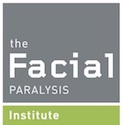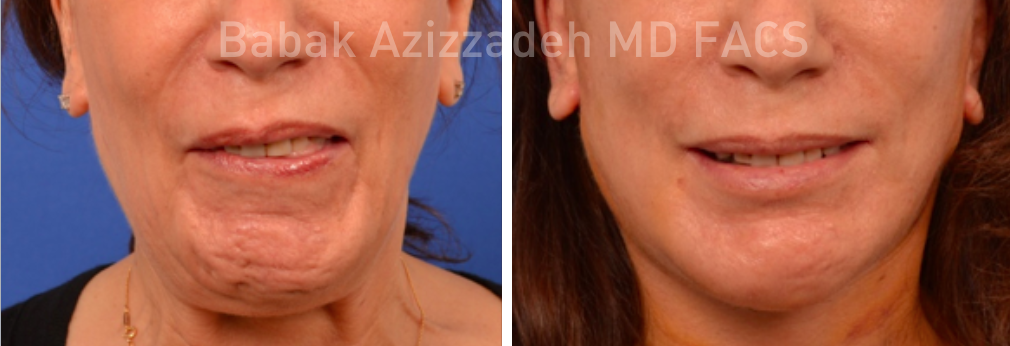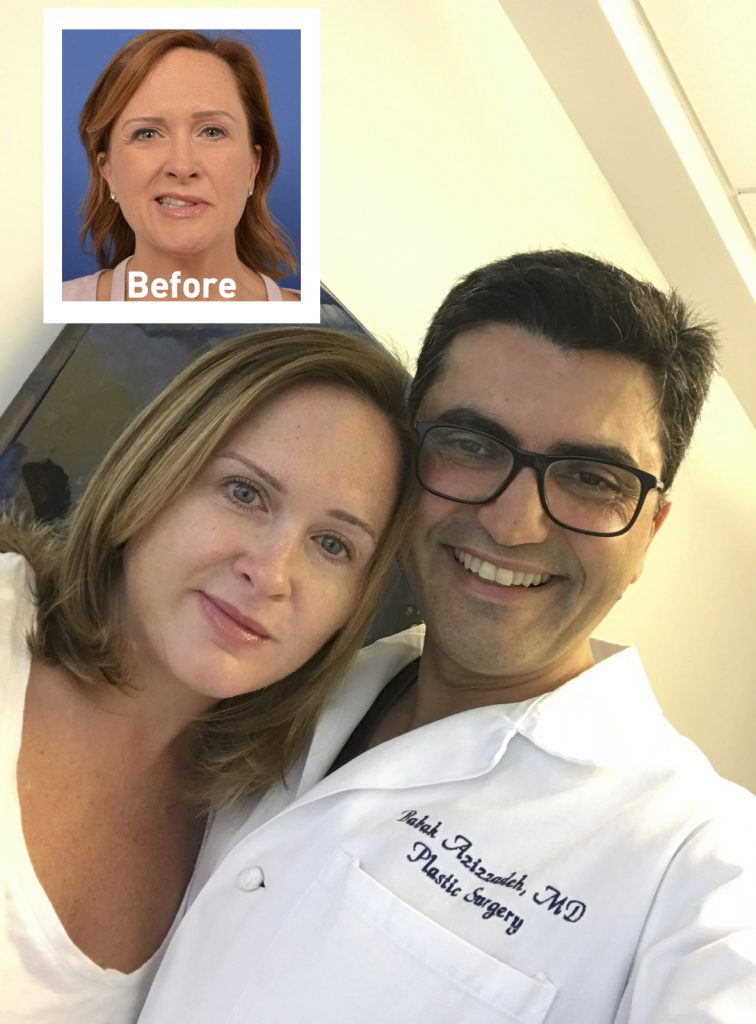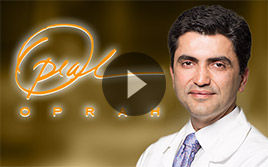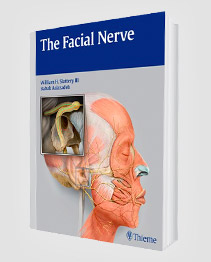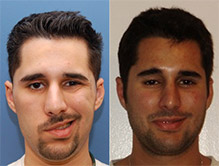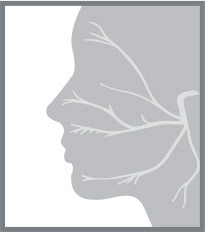Dr. Babak Azizzadeh of the Facial Paralysis Institute is the pioneer of the groundbreaking smile reanimation surgery called selective neurolysis. This Facial Paralysis Selective Neurolysis Surgery is the first permanent treatment option for patients who do not recover from Bell’s palsy, have synkinesis, facial paralysis, Ramsay Hunt Syndrome, acoustic neuroma or traumatic brain injury. While there are facial paralysis and synkinesis procedures currently available to patients, none are able to achieve the components of a natural smile as impressively as selective neurolysis for Synkinesis. Dr. Azizzadeh developed this procedure to improve his patients’ quality of life and non-verbal communication capabilities by creating a natural, spontaneous smile.
What Is Selective Neurolysis?
Selective neurolysis (also referred to as modified selective neurectomy) is the most cutting-edge surgical advancement for patients who are not able to generate an appropriate smile due to partial facial paralysis, permanent Bell’s palsy, or synkinesis. The selective neurolysis for Synkinesis treatment goes to the root of the problem, which is the abnormal regeneration of the facial nerve. Dr. Azizzadeh corrects this “mis-wiring” and the facial reanimation results are phenomenal.
The modified Facial Paralysis Selective Neurolysis Surgery involves meticulously mapping out the facial nerves with intraoperative electromyography (EMG) and selectively decreasing the activity of the nerves that are counterproductive to the smile mechanism. Additionally, Dr. Azizzadeh will release the platysma muscle that pulls the corner of the mouth down. This technique allows for spontaneous reanimation of the face and a natural looking smile. While modified selective neurolysis for Synkinesis is an intricate operation, it is performed at an out-patient surgery center, downtime and risks involved for the patient are limited compared to other facial nerve surgeries, patients can start to see improvement with their smile as soon as one day following surgery.
Infographic on Selective Neurolysis
During a patient consultation, Dr. Azizzadeh will evaluate a patient’s current smile capabilities and determine if they are a candidate for selective neurolysis. One of the greatest benefits of modified selective neurolysis for Synkinesis and facial paralysis is that Dr. Azizzadeh customizes the surgery to the specific needs of the patient, as no two patients are exactly the same.
Before & After Modified Selective Neurectomy Videos
Why Is Selective Neurolysis Used to Treat Bell’s Palsy?
Bell’s palsy, a leading cause of facial paralysis, immediately hinders facial muscle movement and coordination. It often disappears on its own within a few months of diagnosis. But if Bell’s palsy symptoms linger, Facial Paralysis Selective Neurolysis Surgery may be required.
Selective neurolysis treatment has been shown to help Bell’s palsy patients achieve a natural-looking smile. The procedure allows Bell’s palsy patients to limit activity that otherwise affects facial nerves that hamper the smile mechanism. Plus, modified selective neurectomy delivers fast improvements — in some instances, as soon as the day after surgery.
Why Is Selective Neurolysis Used to Treat Synkinesis?
Facial synkinesis, a condition that causes involuntary facial movement of certain muscles due to voluntary facial movement of other muscles, can be problematic. Individuals dealing with synkinesis may experience narrowing of the eyes when they smile, facial twitching that affects the cheek and chin and related symptoms.
With selective neurolysis for Synkinesis, an individual can tackle issues related to impaired facial muscle coordination, contracted and tense facial muscles, as well as various manifestations of synkinesis. Modified selective neurectomy is ideal for synkinesis patients who cannot achieve a natural-looking smile, as the procedure has minimal risks in comparison to similar procedures. Also, the Facial Paralysis Selective Neurolysis Surgery helps synkinesis patients simultaneously improve facial and smile symmetry and facial muscle coordination.
How Do You Treat Facial Paralysis and Synkinesis With Selective Neurolysis?
Most patients who do not recover fully from Bell’s palsy develop synkinesis, which is the simultaneous activation of the nerves and usually needs a selective neurolysis surgery. As a result, when patients with synkinesis try to generate a smile, multiple muscles (depressor anguli oris, platysma, orbicularis oris, and buccinators) get activated and the smile appears pulled down and looks asymmetric. A natural smile is spontaneous, displays overall symmetry in the laugh lines, teeth show (both upper and lower) and timing, and moves in an upward direction. Permanent Bell’s palsy and synkinesis inhibit these components of a natural smile. The only true way to get improvement is the selective neurolysis for Synkinesis treatment that will impact all of these muscles that are counterproductive at the root of the problem, which is the facial nerves.
During a modified Facial Paralysis Selective Neurolysis Surgery, all of the facial nerve branches that go to the facial muscles are identified. All of the nerve branches that go into the key smile muscles are preserved, while Dr. Azizzadeh reduces the activity of the nerves going into the muscles that negatively impact the smile. This approach allows him to treat the core of the problem and achieve results that are extraordinarily better than any other selective neurolysis for Synkinesis treatment option.
Selective Neurolysis & Dr. Azizzadeh on The Dr. Oz Show and Inside Edition
“It’s the first time in 25 years that when I smile, I can see the side of my teeth,” Mary Jo Buttafuoco.
What Are the Benefits of Modified Selective Neurectomy?
Selective neurectomy can help a patient achieve the following results:
- Improved facial and smile symmetry
- Reduced functional tightness
- Enhanced facial muscle coordination
- Restoration of a dynamic smile
Few facial reanimation techniques help individuals achieve the components of a natural smile. Selective neurolysis has proven to be an effective long-term treatment for synkinesis and significantly enhances patients’ smile capabilities.
Additionally, unlike some of the other smile reanimation procedures that require multiple surgeries and can take two to three years to experience smile results, modified selective neurolysis for Synkinesis is a one-stage surgery. As such, the results of modified selective neurectomy can be seen as soon as one day after surgery with full results in just a couple of months.
What Should a Patient Expect from Facial Paralysis Selective Neurolysis Surgery?
Selective neurectomy is a complex procedure, but the recovery period and potential side effects are limited compared to other facial reanimation procedures. Patients experience improvement in the generation of a natural smile within days of surgery, with final results continuing to improve over the next couple of months.
Following the selective neurolysis surgery, Dr. Azizzadeh may recommend his patients complete a neuromuscular retraining program designed to continue to help facilitate facial symmetry and improve facial movement. The physical therapist will teach a patient the proper exercises and provide customized sessions based on the facial movement needs of the patient.
Also, a patient may require periorbital and contralateral Botox after the procedure. Botox consists of a protein derived from the botulinum toxin and is one of the most effective selective neurolysis for Synkinesis treatments for partial facial paralysis and synkinesis patients. It helps relax unwanted muscle movements in the face and reduce tension in areas of the face that are hyperactive due to synkinesis.
Is a Facial Paralysis Selective Neurolysis Surgery Necessary?
The goal of selective neurolysis surgery is to help a patient regain the ability to naturally produce facial expressions. Dr. Azizzadeh recommends a selective neurolysis procedure if he believes a patient can benefit from it. To determine a patient’s eligibility for modified selective neurolysis for Synkinesis and facial paralysis, Dr. Azizzadeh requires a consultation. During the consultation, Dr. Azizzadeh examines his patient and determines if selective neurolysis surgery or other treatment options can deliver the optimal results.
Is Selective Neurolysis Available to Patients of All Ages?
Dr. Azizzadeh has performed selective neurolysis surgery on men and women. Yet, there may be instances when a patient — regardless of age — has one or more preexisting medical conditions that increase the risk of modified selective neurectomy complications. In these instances, Dr. Azizzadeh will not recommend a selective neurolysis procedure.
It is important to note that there are risks associated with selective neurolysis and other facial paralysis treatments. Dr. Azizzadeh analyzes a facial paralysis patient and identifies the risks associated with various treatment options. He then tailors a treatment to his patient, so he or she can achieve the intended results without putting their health in danger.
Is Facial Paralysis Selective Neurolysis Surgery Safe?
Dr. Azizzadeh is a world-renowned facial plastic and reconstructive surgeon. He spearheaded the development of a modified selective neurolysis for Synkinesis and performs the procedure only if he believes it is a safe option for a patient.
To determine if this is the right treatment for a patient, Dr. Azizzadeh requests a consultation. This allows Dr. Azizzadeh to analyze a patient and understand his or her facial paralysis symptoms.
If Dr. Azizzadeh believes modified selective neurectomy can safely and effectively help a patient achieve a natural smile, he creates a treatment plan. Or, if Dr. Azizzadeh deems the selective neurolysis for Synkinesis and facial paralysis surgery to be too risky for a patient, he offers alternative treatment options.
Study on Modified Selective Neurectomy for Post-Facial Paralysis Synkinesis
A recent study of 63 patients revealed that modified selective neurectomy provides an effective long-term treatment for post-facial paralysis synkinesis. Dr. Azizzadeh has published an article that details the study results – read the article to learn more.
What to Expect During a Modified Selective Neurolysis for Synkinesis Treatment Consultation
Dr. Babak Azizzadeh is a Harvard-trained facial paralysis and reconstructive surgeon with a special focus in nerve disorders and treatments. During a consultation, Dr. Azizzadeh will discuss all treatment options with the patient. If Dr. Azizzadeh determines a patient is a candidate for Facial Paralysis Selective Neurolysis Surgery, he will develop a customized treatment plan.
During a consultation, Dr. Azizzadeh will discuss all treatment options with the patient. If Dr. Azizzadeh determines a patient is a candidate for modified neurolysis for Synkinesis, he will develop a customized treatment plan.
In some instances, Dr. Azizzadeh may recommend this surgery be performed in combination with any of the following procedures:
- Asymmetric Facelift: Enables a patient to correct facial asymmetry, leading to a more balanced and natural-looking facial appearance.
- Blepharoplasty (Eyelid Surgery): Helps a patient minimize the appearance of droopy eyelids and may involve the removal of excess fat, muscle and skin.
- Facial Rejuvenation: A patient can also elect to undergo facial rejuvenation procedures at the same time as selective neurolysis. This can include a facelift and neck lift.
Will Patients Experience Facial Paralysis Symptoms after a Selective Neurolysis for Synkinesis Procedure?
Facial Paralysis Selective neurolysis surgery is designed to limit the risk of complications and provide long-lasting results. If a patient undergoes a selective neurolysis procedure and experiences facial paralysis or other symptoms after treatment, consult with Dr. Azizzadeh. At this point, Dr. Azizzadeh can evaluate the patient and determine a viable treatment to correct these symptoms.
Is a Selective Neurolysis Procedure the Best Option to Treat Facial Paralysis Symptoms?
The benefits of selective neurolysis surgery can be significant, but the procedure is not intended for every facial paralysis patient. By meeting with Dr. Azizzadeh, a patient can gain insights into the treatment, how it works, and if he or she is a good candidate for selective neurolysis for Synkinesis and facial paralysis procedure. If a patient qualifies for a modified Facial Paralysis Selective neurolysis surgery, Dr. Azizzadeh can then provide a personalized treatment plan.
Why Should You Choose Dr. Azizzadeh for a Selective Neurolysis Procedure?
Dr. Azizzadeh is a highly trained facial plastic and reconstructive surgeon with many years of industry experience. He pioneered selective neurolysis and is the only facial plastic and reconstructive surgeon to perform multiple selective neurolysis for Synkinesis procedures each week. Dr. Azizzadeh also customizes each procedure to accommodate his patient’s treatment goals. In doing so, Dr. Azizzadeh helps patients achieve unprecedented smile reanimation results.
Dr. Azizzadeh is a globally recognized facial plastic and reconstructive surgeon who tailors each procedure to his patient. Before selective neurolysis is performed, Dr. Azizzadeh learns about his patient’s facial paralysis symptoms. Dr. Azizzadeh also evaluates a facial paralysis patient’s medical history. If Dr. Azizzadeh determines a patient is a good candidate for selective neurolysis for Synkinesis and facial paralysis procedure, he then crafts a custom treatment program. Or, if Dr. Azizzadeh believes selective neurolysis won’t help a patient correct his or her facial paralysis symptoms, he provides alternative Facial Paralysis Selective neurolysis surgery treatment options.
Dr. Azizzadeh provides comprehensive support throughout a facial paralysis treatment program, too. He works closely with a patient to ensure this individual can overcome his or her facial paralysis symptoms. Plus, Dr. Azizzadeh monitors a patient’s progress in the weeks and months following treatment. In doing so, Dr. Azizzadeh helps a patient achieve the best-possible facial paralysis treatment results.
Additionally, Dr. Azizzadeh is an expert resource for facial paralysis patients. Dr. Azizzadeh is committed to educating facial paralysis patients about all aspects of selective neurolysis. As such, Dr. Azizzadeh is happy to provide facial paralysis patients with expert responses to their concerns and questions.
Schedule a Selective Neurolysis Consultation in Beverly Hills with Dr. Azizzadeh
There is no shortage of facial paralysis treatments available, and as a result, determining the best course of action to address facial paralysis symptoms is sometimes difficult. Fortunately, by meeting with Dr. Azizzadeh, an individual, can explore selective neurolysis as a treatment options.
To schedule a consultation with Dr. Azizzadeh, please contact The Facial Paralysis Institute at 310-657-2203 or email us.
Request your consultation with Dr. Azizzadeh today
Call us at (310) 657-2203 to schedule an appointment.
Schedule a Consultation